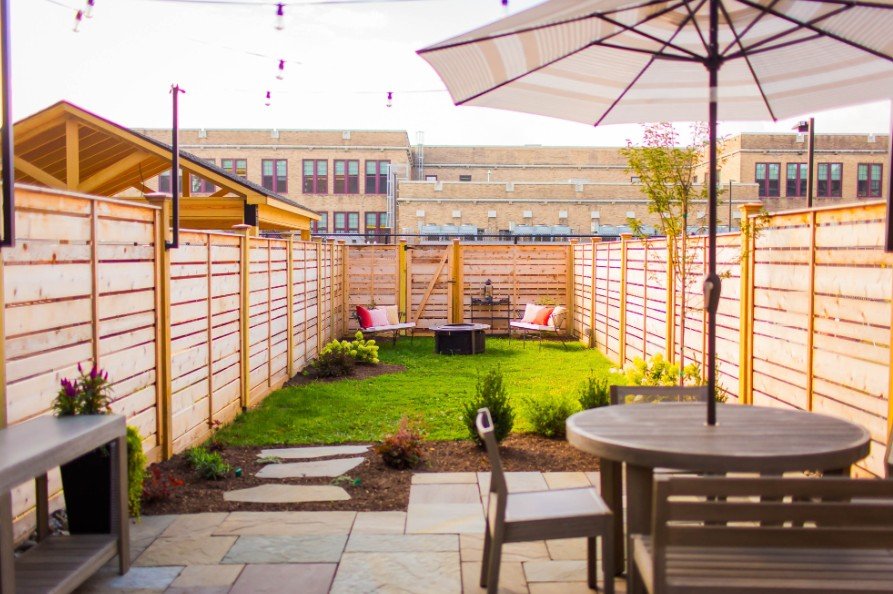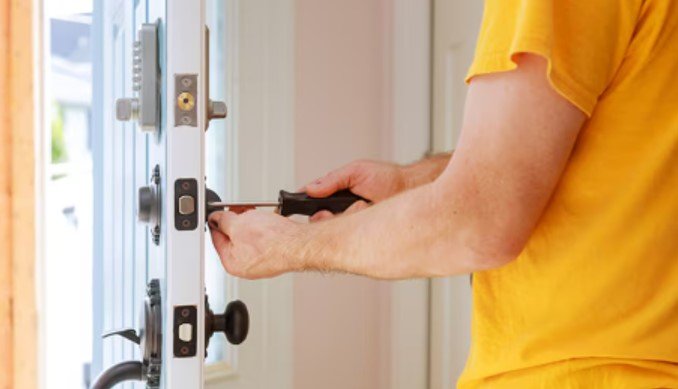4 winter catastrophes and how to prevent and fix them

It’s called “catastrophizing”—lying awake, fretting about your job or the kids or the dumb thing you said to the neighbours and whether they’ll ever speak to you again and could you be a pariah and is it time to move so that your family has a fresh start…
Whoa. Relax. Think of your Happy Place, snuggled beneath a blanket of white. A heavy blanket, thanks to that last storm. How strong is that roof, anyway? The ice dams alone could be a disaster. What if the power goes out and the pipes freeze? Or next week’s polar vortex gives the deck the heave-ho?
We get it—it’s easy to fret about the cottage on a stormy night, especially when you’re not around to keep an eye on things. But a little planning and maintenance will help you sleep better, and ensure your cottage toughs out another winter. Let’s focus on the likely outcomes, not just the worst-case scenarios. And remember your coping skills and your ability to learn, adjust, and fix things. Trust us, you’ve got this.
1. Roof collapse
The worst case Pointy thing on top of the cottage suddenly becomes flat or concave, and is much less useful.
How likely is that? It’s not—if you’ve followed the building code. Canadian codes require that roofs outmuscle the worst combined snow and rain load encountered over 50 years. In Sudbury, Ont., that’s a robust 2.9 kilopascals (about 60 pounds per square foot). For the East Kootenay Village of Nakusp, B.C., it’s a mighty 4.5 kilopascals—94 pounds per square foot. Put that in your snowglobe and shake it.
When collapses occur, they’re usually due to “pre-existing construction or maintenance deficiencies,” says forensic structural engineer Nabi Goudarzi, of Origin and Cause in Ottawa. Maybe your cottage was built before the code, or without reference to it. Or the years have worn down a less-than robust design until the roof got wobbly.
Common problems Improperly aligned, undersized, poorly spliced or rotting rafters; rafters that are too widely spaced; rafters and trusses that are inadequately braced; or builders who’ve scrimped on nails. (Yes, that really happens.) There’s also the bane of middle-aged cottages, rafter spread. “It could even progress to the point of pushing out the exterior supporting walls, leading to failure of the roof and possibly the wall structure,” says Roger Frost, a home inspector in Orillia, Ont.
This clever snow removal tool makes clearing your roof a cinch
What should I look for? “Wood framing has flexibility,” Goudarzi says. “Before it gets to the point of collapse, you can see cracks in the gypsum boards or sagging on the roof.”
Sheds are apt to collapse without warning because “they don’t have interior finishes so there will be no early cracking before the collapse,” Goudarzi says. But if a shed falls at your neighbours’ and there’s someone there to hear it, it makes a sound: “Ten minutes before the collapse, I heard what sounded like nails popping. I thought it was snow starting to slip on the roof,” says Kim Pressnail, an associate professor emeritus with the University of Toronto’s department of civil and mineral engineering.
The fix “If you see sagging and cracking, call a building inspector,” Goudarzi says. The solution may be as simple as reinforcing rafters or improving bracing. With the advice of a structural engineer, “a lot of these problems, if they’re caught before the damage occurs, can be fixed very easily.” (The cost would vary with the amount of damage and the size of the cottage.)
How to tell if a wall is load bearing
2. Ice dams
The worst case “Failure of the roof deck, severe mould, and increased damage to other parts of the cottage,” says Paul Grizenko of Montreal-based PRS Roofing. “I’ve seen people with their kitchen ceiling cave in, or a big amount of mould building up in the attic that they had no idea about. The vapour barrier was effectively trapping all the water up there.”
Ice dams form when meltwater, warmed by the sun or attic heat, refreezes on the eaves’ cold edges. Water backs up behind this icy dam, flows beneath the roofing, and seeps into the attic or walls.
How likely is that? Pretty darn likely—at least, if leaks go unchecked. “Ice dams are like having an overflowing bathtub on top of the roof,” Grizenko says. “If you catch it early, you can clean it up. If you let it run, you’re going to have major problems.”
10 rules of rooftop de-icing
Common problems Interior leaks, damage, rot, and mould.
What should I look for? Ice building up along the edge of the roof, a frozen Niagara of icicles on the eaves, and telltale water stains on ceilings or exterior walls.
The fix “Ice dams are a function of heat loss. The quantity and quality of your insulation is probably the most important aspect. Once you get the insulation right, the next part is ventilation,” Grizenko says.
“A lot of older cottages have insufficient insulation, particularly at the junction where the roof and walls meet. As heat is transferred through framing members, it warms the roof deck and melts the snow,” adds Roger Frost.
Keep heat out of the attic by insulating and sealing the hatch and penetrations for pipes, plumbing stacks, electrical services, and chimneys. Recessed incandescent lights are also big heat-wasters, so consider replacing them with Insulation Contact (IC)-rated units. Good ventilation also whisks remaining heat and moisture from the attic. If you don’t see roof, gable, and soffit vents on your cottage (especially if it’s older), ask a roofer whether the venting is adequate.
Install snow-and-ice membrane next time you re-roof. “If it’s done well, you can still have an ice dam up there, but the water won’t get in,” Grizenko says. Electrical heating cables can help clear roof eaves, so long as they’re strung “above the point where ice dams typically form,” Grizenko says, and placed so the heating effect from one cable overlaps the heat coming from the next. Keep meltwater moving with additional cables in gutters and downspouts.
Ventilation in an uninsulated attic
Buy a telescoping snow rake, and use it to reduce snow load and damming. “You don’t need to take the snow right down to the shingles,” says Colin Marshall of Barrie’s Will Marshall Insurance Brokers (who has 15 years of experience plus his own snow-load run-ins at his vacation place in Sudbury, Ont.). Even when you can’t reach all the snow, raking off the bottom two metres or so, all the way around the roof, will help.
Just remember, never chip ice off the roofing—that will shorten its life. “Ice doesn’t just sit on top of the shingles, it encases them,” Grizenko says.
3. Bursting pipes
The worst case A heating or hydro interruption that causes pipes to freeze, split, and then thaw when the power is restored is a recipe for disaster in an unattended cottage. Jeremy Begin of Cottage Country Plumbing in Bracebridge, Ont., has seen heating systems fail and waterlines freeze, leaving a “six-foot-deep ice block” in the basement. Because there were multiple leaks, the main floor was “an ice cave, complete with icicles coming from the ceiling,” he says.
“I have seen basements completely full of water and what looks like frozen waterfalls spilling out of patio doors,” says Bruce Hodgson of Water’s Edge Plumbing in Lac du Bonnet, Man. Outside the cottage, “in a case where waterline freezing is extensive, it will sometimes require us to completely re-pipe a home or cottage—everything from the pump and waterlines to the faucets and toilets.”
Cottage Q&A: PEX pipe vs copper
How likely is that? Likely enough that most insurers require you to drain the water system and have someone check the place every three days or install automated freeze alarms. For cottages with regular winter use, “turn the water off at the main and run the tap at the lowest point in the plumbing system. You will have eliminated most of the water,” says Colin Marshall. “If it does freeze, there’s more give in the system for water to expand.”
Common problems “Frost-free” outdoor taps (a.k.a. “wall hydrants”) split when cottagers forget to disconnect the hose and drain the valve. “Most people don’t find out until they use the tap in the spring, and it’s leaking all over their basement or crawl space,” Hodgson says.
Other headaches include the water service freezing where it enters the cottage (often due to heating cable failure), and septic systems and drain pipes chilled when there’s too little insulating snow, or when the snow has been compressed by snowmobile traffic.
What should I look for? Find frozen pipes by locating the taps that aren’t running, and work your way back to icy sections. Check for chilly or drafty zones in cabinets beneath sinks, or crawl spaces. Sometimes, you can feel them with your hand or find stiff sections in PEX pipe. A digital temperature gun helps too. For pipes concealed in floors or walls, check for the coldest floor or wall surfaces in the draftiest and poorest-insulated areas.
How to deal with frozen pipes
The fix Inside, turn off the water where it enters the cottage, leave the tap open, and wrap accessible frozen pipes with towels and pour warm water over them, or use a heat source (eg., hair dryer, heat gun, or portable heater). Thaw the pipe from the tap end, so any pressure buildup from water turning to steam escapes from the spigot. (Or don’t thaw, and wait for a professional, advises Begin. There is a chance that there’s a split somewhere in the pipe. If you thaw it, you could risk water spraying everywhere.) For concealed pipes, you could gamble that they’re okay, try cranking the heat, and watch for leaks. But this can be a slow process, and if the pipe does require a fix, you’ll still have to cut into drywall or flooring.
Small splits in copper can be soldered. If pipes require replacement, consider PEX—it has some flex, unlike copper. Outside, you may have to wait until plumbing thaws in the spring or hire a plumber to steam ice from drains or waterlines. If your septic system suffers from a deep chill, you might also need a follow up inspection by a contractor, scouting for cracked or burst components.
How to make your three-season plumbing work all winter
Unless you’re draining the pipes, set the heat at 12°C or warmer, and insulate areas where cold air chills pipes in interior walls, cupboards on exterior walls, and cold-exposed areas of basements or crawl spaces. “For frost-prone lines, heating cables are an effective way to prevent many problems,” Hodgson says.
Keep snow over septic areas and waterlines, or supplement with bales of straw or purpose-made insulating “septic blankets.” You can also excavate the line and install rigid foam insulation.
4. Frost heaving
The worst case “Foundation collapse,” says Ari Marantz of Winnipeg’s Trained Eye Home Inspection. “I’ve seen where the cottage falls off the posts and is sitting on the ground.” Freezing soils can also crack mortar joints on unheated block basements, leaving them bowed and displaced, says engineering professor Kim Pressnail.
How likely is that? It’s location, location, location, says Pressnail. Given the right mix of water, sub-zero temperatures, and soils full of “the S-word—silt,” Pressnail says your cottage can lean like Italian architecture.
Common problems The culprit is ice lenses, disc-shaped collections of ice crystals in the soil. Lenses grow by wicking water from deep, warm ground, and drawing towards colder areas. Usually that means they’ll rise towards the cold surface, “jacking” cottage piers, deck posts, and culverts on the way. But with an unheated basement, lenses can push towards the cold blocks, shoving them in.
6 signs of a failing foundation
What should I look for? As with snow load, a shifting foundation is forcing your cottage to flex. Look for cracks, buckling walls, and jamming doors. Outside, “look at other buildings. Have they moved around or tilted? Do you see frost heaves on the road? Culverts lifting? Sidewalks and fence posts jacking out of the ground? If your neighbour’s cottage is on piers and its ridgeline looks irregular or is sagging like an old horse, chances are you’re in a frost-prone area,” says Pressnail.
The fix Put new footings well below the frost line and get knowledgeable advice. “Experienced building inspectors know the soils in their areas, know what does work and what doesn’t work,” Pressnail says. “People see them as a pain, but they’re there to help you.”
If piers or posts are shifting, “you’ll need to call somebody in to lift and level the cottage,” Marantz says. Ditto for wall repairs, which will require extensive excavation. Adding free-draining soil around the cottage perimeter helps, Pressnail says, but he also suggests insulating floors, walls, and even the ground around frost-troubled cottages. A horizontal layer of extruded polystyrene foam, buried for about 30 cm around the cottage, creates an insulating buffer against frost and ice lenses. “It’s equivalent to snow,” Pressnail says, “but it’s always there.”
You’re not alone in this, cottagers!
You don’t have to handle this on your own. Track winter conditions by reaching out to neighbours and keeping in touch with your lake association. Consider a camera that lets you check snow load and ice dams, or heat and leak sensors inside the cottage, or even automated valves that will shut down the water system if a leak is detected. But technology can only do so much. You’ll still need a neighbour, a cottage-watching service, or your own presence when something seems amiss. Consider it an IRL excuse to visit your Happy Place.
3 common cottage foundations and possible fixes
Catastrophes do happen, and winter is hard on stuff. Even with climate change, “less cold doesn’t mean never cold. It doesn’t mean we’ll be the Miami of the North,” says David Phillips, the senior climatologist for Environment and Climate Change Canada. In a warmer, wetter, more unsettled winter, the next couple of decades will likely still feature what Phillips calls “Paul Bunyan snowfalls” off the Great Lakes, plus more freezes and thaws, more ice storms, and the odd Polar Vortex. (Brrr.) The cold hard truth? Planning for winter can help you chill. Lying awake at night, fearing the worst, will not.
This article was originally published in the Winter 2022 issue of Cottage Life.

Build it, fix it, get it done!
Get Dockside DIY, for tips on how to maintain your cottage…and then some
Sign up here
Featured Video

Related Story Before you buy, check these 10 things that can be costly surprises

Related Story Q&A: Mouse-proofing a winterized cottage








